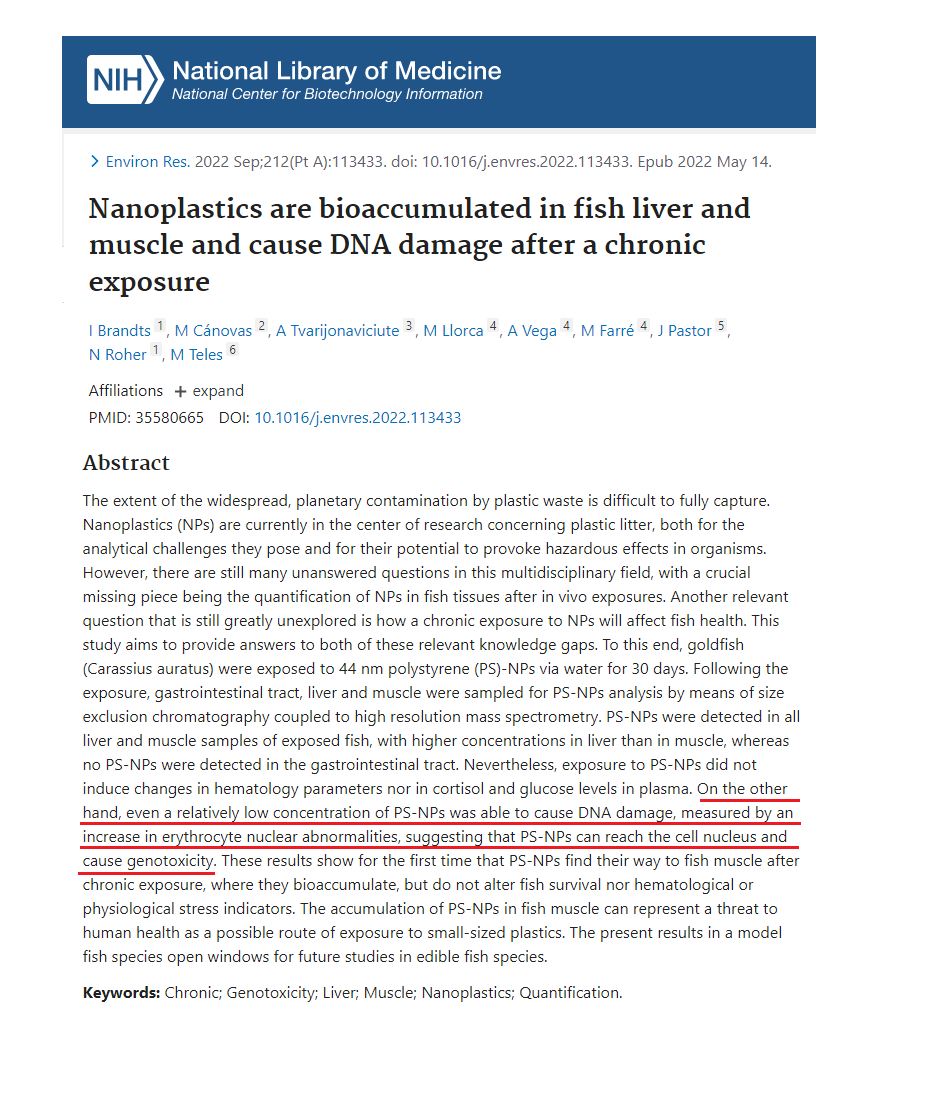Nanoplastics are bioaccumulated in fish liver and muscle and cause DNA damage after a chronic exposure
Link: https://pubmed.ncbi.nlm.nih.gov/35580665/
I Brandts 1, M Cánovas 2, A Tvarijonaviciute 3, M Llorca 4, A Vega 4, M Farré 4, J Pastor 5, N Roher 1, M Teles 6
Affiliations
- PMID: 35580665
- DOI: 10.1016/j.envres.2022.113433
Abstract
The extent of the widespread, planetary contamination by plastic waste is difficult to fully capture. Nanoplastics (NPs) are currently in the center of research concerning plastic litter, both for the analytical challenges they pose and for their potential to provoke hazardous effects in organisms. However, there are still many unanswered questions in this multidisciplinary field, with a crucial missing piece being the quantification of NPs in fish tissues after in vivo exposures. Another relevant question that is still greatly unexplored is how a chronic exposure to NPs will affect fish health. This study aims to provide answers to both of these relevant knowledge gaps. To this end, goldfish (Carassius auratus) were exposed to 44 nm polystyrene (PS)-NPs via water for 30 days. Following the exposure, gastrointestinal tract, liver and muscle were sampled for PS-NPs analysis by means of size exclusion chromatography coupled to high resolution mass spectrometry. PS-NPs were detected in all liver and muscle samples of exposed fish, with higher concentrations in liver than in muscle, whereas no PS-NPs were detected in the gastrointestinal tract. Nevertheless, exposure to PS-NPs did not induce changes in hematology parameters nor in cortisol and glucose levels in plasma. On the other hand, even a relatively low concentration of PS-NPs was able to cause DNA damage, measured by an increase in erythrocyte nuclear abnormalities, suggesting that PS-NPs can reach the cell nucleus and cause genotoxicity. These results show for the first time that PS-NPs find their way to fish muscle after chronic exposure, where they bioaccumulate, but do not alter fish survival nor hematological or physiological stress indicators. The accumulation of PS-NPs in fish muscle can represent a threat to human health as a possible route of exposure to small-sized plastics. The present results in a model fish species open windows for future studies in edible fish species.
Keywords: Chronic; Genotoxicity; Liver; Muscle; Nanoplastics; Quantification.

See free reviews and follow our informative Blog to learn more: http:// https://implante.institute/blog
See free analysis at: https://implante.institute/analises?perm_status=1
#implantinstitute #implantcontamination #contamination #implantlost #titanium #zirconia #metal #aluminumfree #toxic #alumina #odontistry #materialscience #cellbiology #implantdentistry #dentist #implant #dental #dentalcare #plantcontentental #esthetic #cell
A extensão da contaminação planetária generalizada por resíduos de plástico é difícil de capturar totalmente. Os nanoplásticos (NPs) estão atualmente no centro das pesquisas sobre lixo plástico, tanto pelos desafios analíticos que representam quanto pelo potencial de provocar efeitos perigosos nos organismos. No entanto, ainda existem muitas questões sem resposta neste campo multidisciplinar, com uma peça crucial que falta é a quantificação de NPs em tecidos de peixes após exposições in vivo. Outra questão relevante e ainda pouco explorada é como uma exposição crônica a NPs afetará a saúde dos peixes. Este estudo visa fornecer respostas para essas duas lacunas de conhecimento relevantes. Para tanto, peixes dourados (Carassius auratus) foram expostos a NPs de poliestireno (PS) de 44 nm via água por 30 dias. Após a exposição, trato gastrointestinal, fígado e músculo foram amostrados para análise de PS-NPs por meio de cromatografia de exclusão de tamanho acoplada a espectrometria de massa de alta resolução. PS-NPs foram detectados em todas as amostras de fígado e músculo de peixes expostos, com maiores concentrações no fígado do que no músculo, enquanto nenhum PS-NPs foi detectado no trato gastrointestinal. No entanto, a exposição aos PS-NPs não induziu alterações nos parâmetros hematológicos nem nos níveis de cortisol e glicose no plasma. Por outro lado, mesmo uma concentração relativamente baixa de PS-NPs foi capaz de causar danos ao DNA, medidos por um aumento nas anormalidades nucleares dos eritrócitos, sugerindo que PS-NPs podem atingir o núcleo celular e causar genotoxicidade. Esses resultados mostram pela primeira vez que os PS-NPs encontram seu caminho para o músculo do peixe após exposição crônica, onde se bioacumulam, mas não alteram a sobrevivência dos peixes nem os indicadores de estresse hematológico ou fisiológico. O acúmulo de PS-NPs no músculo do peixe pode representar uma ameaça à saúde humana como uma possível via de exposição a plásticos de pequeno porte. Os presentes resultados em uma espécie de peixe modelo abrem janelas para estudos futuros em espécies de peixes comestíveis.
